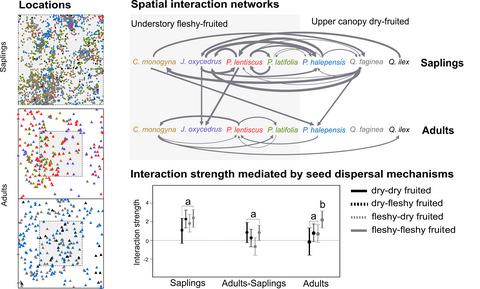Our official English website, www.x-mol.net, welcomes your
feedback! (Note: you will need to create a separate account there.)
Legacy effects of seed dispersal mechanisms shape the spatial interaction network of plant species in Mediterranean forests
Journal of Ecology ( IF 5.3 ) Pub Date : 2021-07-09 , DOI: 10.1111/1365-2745.13744 Antonio J. Perea 1, 2 , Thorsten Wiegand 3, 4 , José L. Garrido 5, 6 , Pedro J. Rey 1, 2 , Julio M. Alcántara 1, 2
中文翻译:

种子传播机制的遗留效应塑造了地中海森林植物物种的空间相互作用网络
更新日期:2021-07-09
Journal of Ecology ( IF 5.3 ) Pub Date : 2021-07-09 , DOI: 10.1111/1365-2745.13744 Antonio J. Perea 1, 2 , Thorsten Wiegand 3, 4 , José L. Garrido 5, 6 , Pedro J. Rey 1, 2 , Julio M. Alcántara 1, 2
Affiliation

|
- Seed dispersal by frugivores plays a key role in structuring and maintaining tree diversity in forests. However, little is known about how the spatial legacy of seed dispersal and early recruitment shapes spatial patterns and the spatial interaction network of plant species in mature forest communities.
- We analysed two fully mapped mixed Pine–Oak forest communities using spatial point pattern analysis to determine (a) the detailed structure of the intraspecific spatial patterns of saplings and adults, (b) the intra- and interspecific spatial interaction of saplings, adults and saplings relative to adults, (c) the spatial patterns of species richness at the community level and (d) whether seed dispersal mechanisms affect the plant–plant interaction networks and the ratio of adult to sapling neighbourhood densities used as surrogate for spatial self-thinning.
- The intraspecific spatial patterns of saplings and adults showed in general complex nested cluster structures that were similar for sapling and adult stages, despite substantial self-thinning in some dry-fruited species. The spatial network of saplings was characterized by positive spatial interactions. Adults of several tree species facilitated saplings in their proximity; however, adults of dry-fruited species, but not those of fleshy-fruited ones, lost almost all positive interactions that occurred at the sapling stage. Besides, interaction strength between adults was positive and often significantly stronger if both species were fleshy-fruited. At the community level, the forests were structured into multispecies clumps across all life stages.
- Synthesis. Our analyses highlight the importance of the spatial legacy of seed dispersal and early recruitment in the assembly of plant communities. Particularly, animal seed dispersal can lead to multispecies clusters and positive spatial associations across life stages in Mediterranean forests, with surprisingly little signatures of negative interactions. Our analysis suggests that changes of the spatial structure across plant life stages are driven by seed dispersal mechanisms and subsequent spatial self-thinning, generating a spatial footprint at the sapling stage that conditions the long-term interactions between adult plants. Combining spatial point pattern analysis with network analysis and species traits is a promising way to disentangle the processes underlying observed patterns of local diversity.
中文翻译:

种子传播机制的遗留效应塑造了地中海森林植物物种的空间相互作用网络
- 食果动物的种子传播在构建和维持森林中的树木多样性方面起着关键作用。然而,关于种子传播和早期补充的空间遗产如何塑造成熟森林群落中植物物种的空间格局和空间相互作用网络知之甚少。
- 我们使用空间点模式分析分析了两个完全映射的混合松树 - 橡树森林群落,以确定 (a) 树苗和成虫的种内空间模式的详细结构,(b) 树苗、成虫和树苗的种内和种间空间相互作用相对于成虫,(c)群落水平物种丰富度的空间模式和(d)种子传播机制是否影响植物 - 植物相互作用网络以及用作空间自我稀疏替代的成虫与幼树邻域密度的比率。
- 树苗和成虫的种内空间模式显示出一般复杂的嵌套簇结构,这些结构与树苗和成虫阶段相似,尽管在一些干果物种中存在大量的自我变薄。树苗空间网络的特点是正空间相互作用。几种树种的成虫促进了它们附近的树苗生长;然而,干果树种的成虫,而不是肉果树种的成虫,几乎失去了幼苗阶段发生的所有正相互作用。此外,如果两个物种都是肉质果实,则成虫之间的相互作用强度是正的,并且通常显着更强。在社区层面,森林被组织成跨越所有生命阶段的多物种丛。
- 合成。我们的分析强调了植物群落组装中种子传播和早期补充的空间遗产的重要性。特别是,动物种子的传播可以导致地中海森林中跨生命阶段的多物种集群和积极的空间关联,令人惊讶的是,负面相互作用的迹象很少。我们的分析表明,跨植物生命阶段的空间结构变化是由种子传播机制和随后的空间自变薄驱动的,在幼苗阶段产生空间足迹,从而调节成年植物之间的长期相互作用。将空间点模式分析与网络分析和物种特征相结合,是解开局部多样性观察模式背后的过程的一种很有前途的方法。











































 京公网安备 11010802027423号
京公网安备 11010802027423号